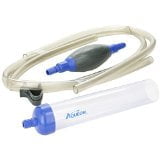GRAVEL vacuum substrate with every water change
STEP 3
Gravel vacuum substrate in your goldfish aquarium or pond. Goldfish spend most every waking moment in search of food. There’s nothing they love better than pecking through gravel and shoving stones around in hopes of finding an uneaten morsel. It’s sad to see a goldfish in an aquarium without gravel; there’s nothing quite as unnatural for a goldfish. Investing in a gravel vacuum is a must if you have a stone substrate
Cleaning goldfish aquarium
Because of this instinct; pecking through the gravel, a stone may become lodged in the fish’s throat, although it’s rare. There’s less risk if natural pea gravel is used due to the irregular shape. Round, pet shop gravel is the culprit here. Most fish are able to expel the object on their own; this may happen within a few minutes or a few hours. If not, action may have to be taken to remove the stone Lodged Stone
Using gravel as a substrate makes for clear water by keeping waste and uneaten food from floating freely in the tank, giving it a place to settle. Use a gravel vacuum to remove the debris from the bottom of your goldfish tank. Since we know that friendly bacteria prefer building their colonies in filters and pumps, we can assume that unfriendly bacteria build their colonies in stagnate locations. We also have learned that performing a 100% water change will destroy good and bad colonies alike, but this makes removing debris and waste that has settled in the gravel difficult unless we use a gravel vacuum
Gravel vacuum substrate
Using a gravel vacuum also helps to reduce carbon dioxide that forms and hangs heavily in the depths of our tanks and ponds. Carbon dioxide is created from the waste your fish produce. Pond pumps do most of work in eliminating these harmful gases that take up space pushing oxygen out
- Python or siphon
A gravel vacuum is actually a short hose or tubing that comes in a few various sizes with a wide mouth on the end of it. Smaller tanks require smaller hose widths to reduce the flow rate

Place the mouth of the vacuum at the bottom of your tank. Using a suction device attached to the center portion of the hose, squeeze repetitively. A motorized pump (python) may also be obtained for simplifying the procedure or you may choose to siphon with your mouth to get the action going
- How use gravel vacuum
Have a bucket handy for the old tank water to spill into, and be careful not to suck small fish into the mouth of the vacuum. Very gently, so as not to pollute the water, rake the mouth through the gravel pulling it backwards; not by pushing it forwards; this will clog the mouth of the vacuum and stop the flow of water. When you have completed the task, gently lift the mouth up as you remove it from tank, allowing the dirty water to drain out into the bucket instead of back washing into the tank. Practice makes perfect
Goldfish care
Use old tank water to water house and outdoor plants. Plants feed on nitrates
To reduce the risk of sucking up small goldfish into the mouth of the vacuum; using a rubber band, fasten a net over the mouth. This might make gravel cleaning a little slower, but better to be safe than sorry. Some goldfish quickly learn that the gravel vacuum stirs up passed over morsels of food, and follow it around, unaware of the danger
Gravel vacuum substrate
The bucket used for old tank water should sit lower than the tank; this makes for a steady flow. Vacuuming a pond that sits below grade is next to impossible unless you’re using a motorized python
- How much and what kind of gravel to use in a goldfish tank
In keeping with a natural ecosystem, use natural pea gravel as shown in the photo below. Natural gravel will assist in buffering the general hardness of your water. These trace minerals which are in all small bodies of water are important to good goldfish health. The natural shapes reduce the risk of swallowing. Keep only a thin layer of gravel in your tank or pond’s bottom; 1/4″ so the goldfish can peck to the bottom. This keeps harmful bacteria from forming in between vacuuming

Never use sand as substrate
Sand irritates the gills and clouds the water, depleting oxygen levels. Sand also encourages harmful bacteria. You won’t find sand in a natural body of water where carp live
Use sea shells and pea gravel to support the vital minerals goldfish and Koi need for good health. No goldfish set up is complete without natural pea (sized) gravel
Marbles are not recommended for use; they often crack and then break; leaving shards of glass that may injure the fish or even worse
Painted pet shop rock often peels as it ages, and does nothing to contribute to the ecosystem
Never use detergents or cleaning agents on your goldfish tank or goldfish equipment. If the ecosystem in your goldfish house or Koi pond is a healthy one, you will never have to clean, although you may need to remove limescale that builds up on the glass. Vinegar works well for this, but the tank will have to be relocated, along with the water during the process, as vinegar, being acidic, lowers carbonate mineral levels, lowering pH
10 Steps to Goldfish Koi Keeping